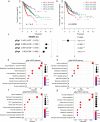A study on metabolic characteristics and metabolic markers of gastrointestinal tumors
- PMID: 37705174
- PMCID: PMC10503448
- DOI: 10.1080/15384047.2023.2255369
A study on metabolic characteristics and metabolic markers of gastrointestinal tumors
Abstract
Tumor cells have significant heterogeneity in metabolism and are closely related to prognosis, gene mutation, and subtype. However, this association has not been demonstrated in reports of gastrointestinal tumors. In this study, we constructed four metabolic subtypes and identified four gene signatures using the expression data and clinical information of 252 metabolism-related genes from TCGA and NCBI databases for gastric adenocarcinoma (STAD) and colorectal cancer (COAD and READ). MC1 had the worst prognosis compared to other classifications. GSig1 was mainly related to drug metabolism and was the highest in MC1 with the worst prognosis, while the other subtypes were mainly related to glucose metabolism pathways. This difference also existed in other different malignant tumors. In addition, metabolic typing was associated with chemotherapeutic drug response and tumor heterogeneity, which indicated that monitoring metabolic typing could contribute to drug efficacy and gene-targeted therapy. In conclusion, we identified differences among subtypes in clinical characteristics such as prognosis and revealed the potential function of metabolic subtype in response to chemotherapeutic agents and oncogene mutations. This work highlighted the potential clinical meaning of metabolic subtype and characteristics in drug therapy and prognosis assessment of malignant tumors.
Keywords: Gastrointestinal tumor; TCGA database; drug response; metabolic subtype; prognosis.
Conflict of interest statement
No potential conflict of interest was reported by the author(s).
Figures









Similar articles
-
Identification of the three subtypes and the prognostic characteristics of stomach adenocarcinoma: analysis of the hypoxia-related long non-coding RNAs.Funct Integr Genomics. 2022 Oct;22(5):919-936. doi: 10.1007/s10142-022-00867-3. Epub 2022 Jun 4. Funct Integr Genomics. 2022. PMID: 35665866
-
Pan-Cancer Analysis of PARP1 Alterations as Biomarkers in the Prediction of Immunotherapeutic Effects and the Association of Its Expression Levels and Immunotherapy Signatures.Front Immunol. 2021 Aug 31;12:721030. doi: 10.3389/fimmu.2021.721030. eCollection 2021. Front Immunol. 2021. PMID: 34531868 Free PMC article.
-
Identification of three immune subtypes characterized by distinct tumor immune microenvironment and therapeutic response in stomach adenocarcinoma.Gene. 2022 Apr 15;818:146177. doi: 10.1016/j.gene.2021.146177. Epub 2022 Jan 20. Gene. 2022. PMID: 35065254
-
Changing pathology with changing drugs: tumors of the gastrointestinal tract.Pathobiology. 2011;78(2):76-89. doi: 10.1159/000315535. Epub 2011 Jun 15. Pathobiology. 2011. PMID: 21677471 Review.
-
Identification and characterization of nucleotide metabolism and neuroendocrine regulation-associated modification patterns in stomach adenocarcinoma with auxiliary prognostic assessment and immunotherapy response prediction.Front Endocrinol (Lausanne). 2023 Jan 16;13:1076521. doi: 10.3389/fendo.2022.1076521. eCollection 2022. Front Endocrinol (Lausanne). 2023. PMID: 36726460 Free PMC article. Review.
Cited by
-
Advances in the diagnosis and treatment of MET-variant digestive tract tumors.World J Gastrointest Oncol. 2024 Nov 15;16(11):4338-4353. doi: 10.4251/wjgo.v16.i11.4338. World J Gastrointest Oncol. 2024. PMID: 39554732 Free PMC article. Review.
References
Publication types
MeSH terms
LinkOut - more resources
Full Text Sources
Medical
